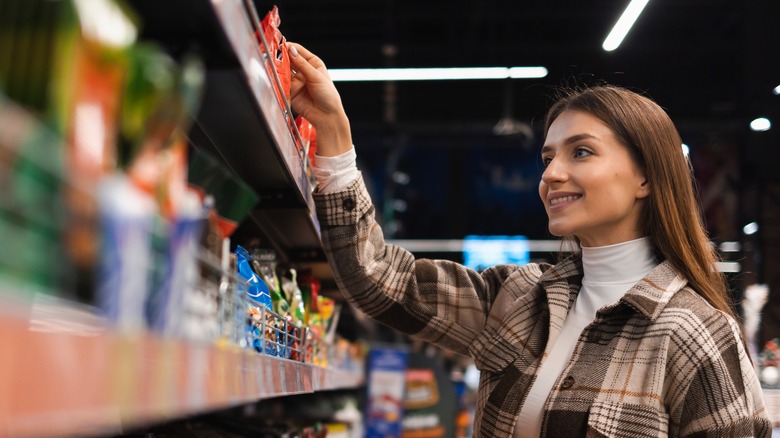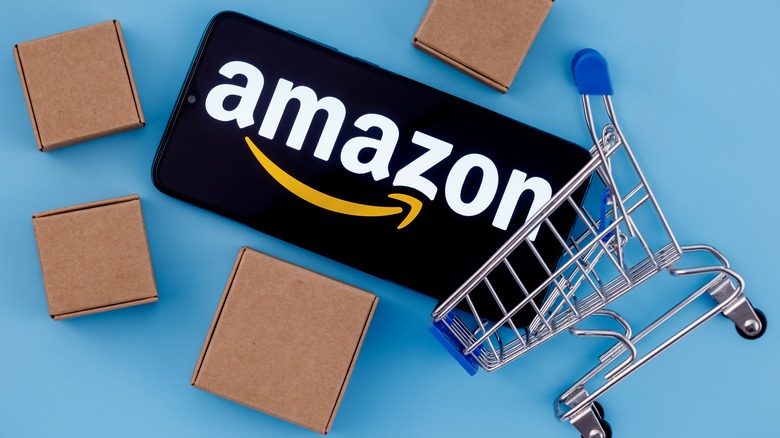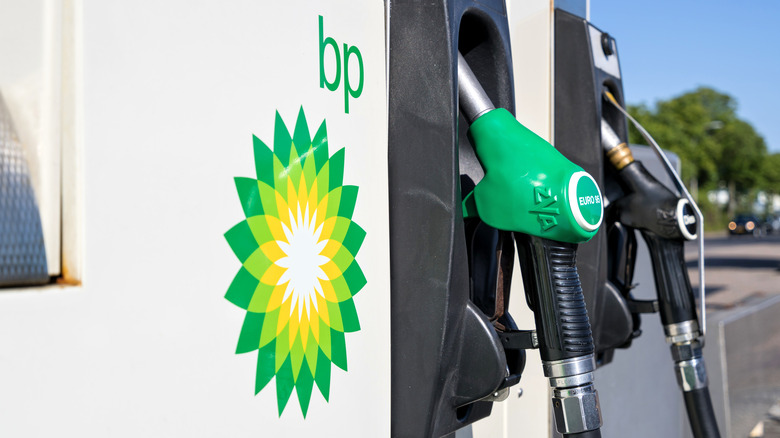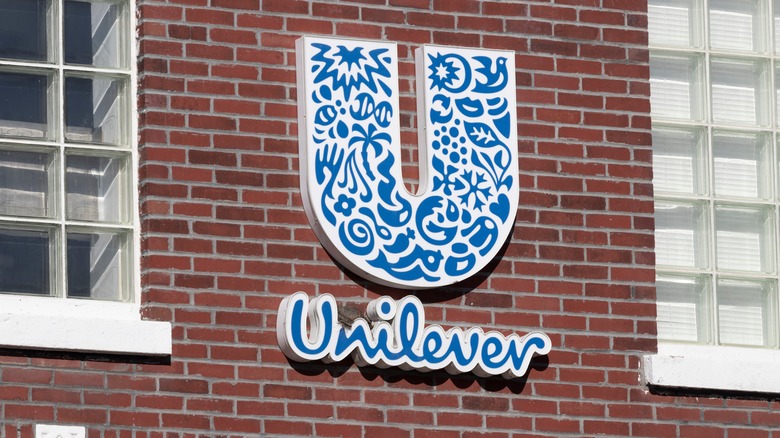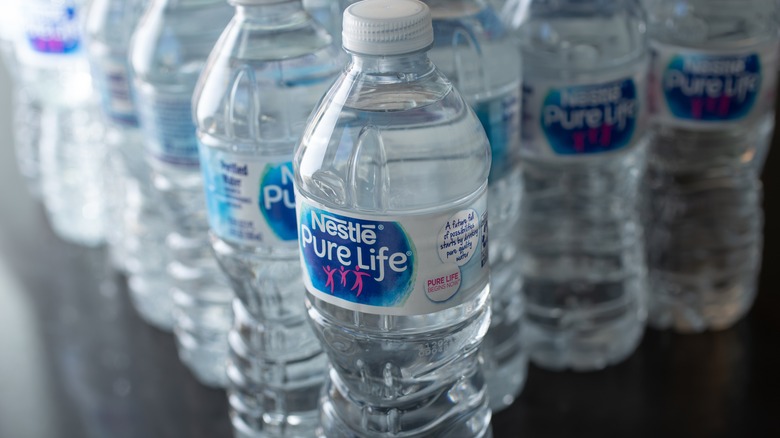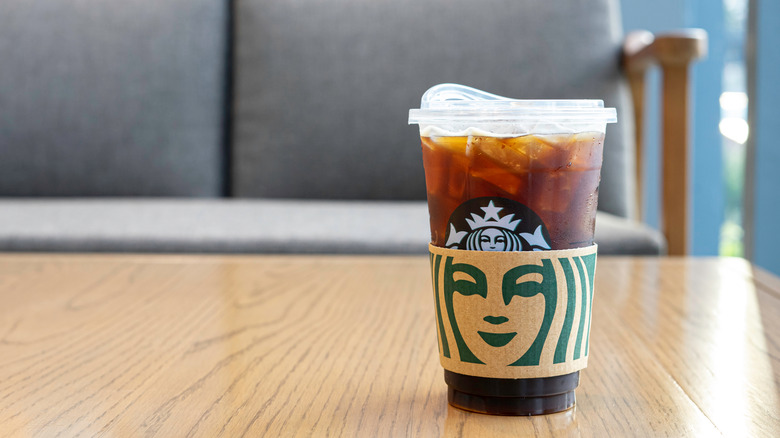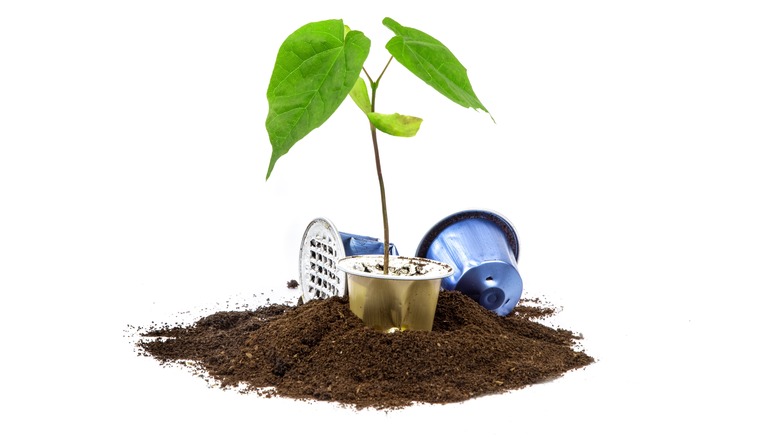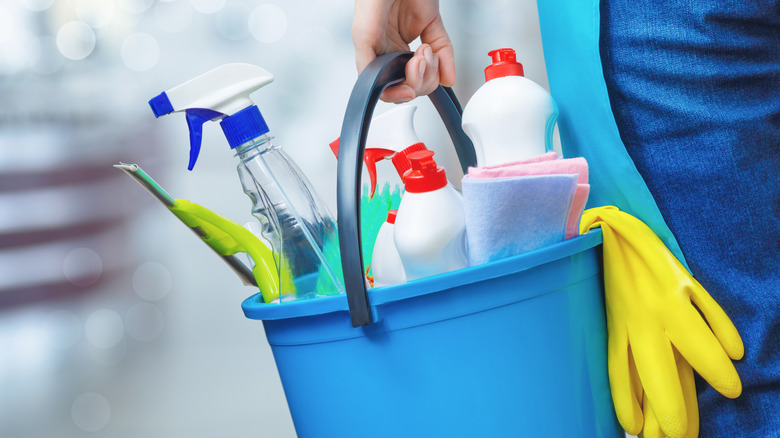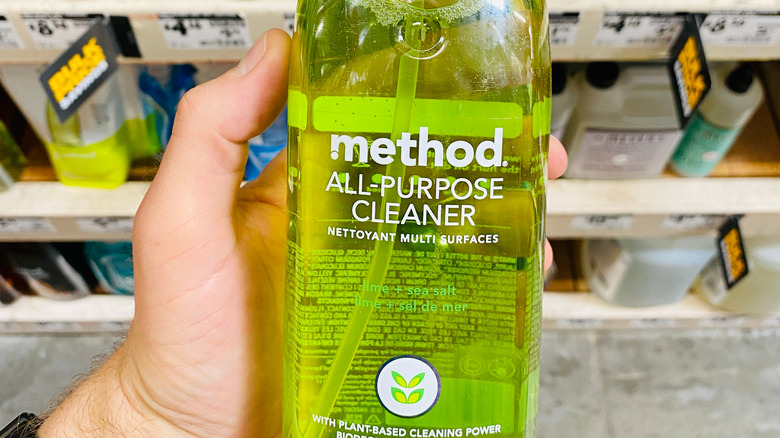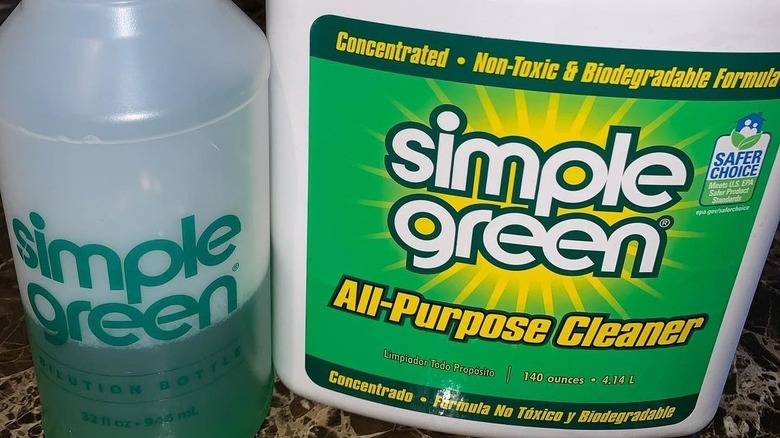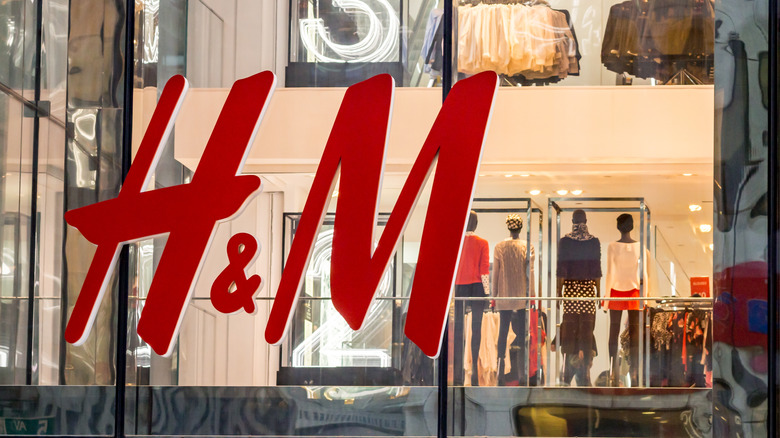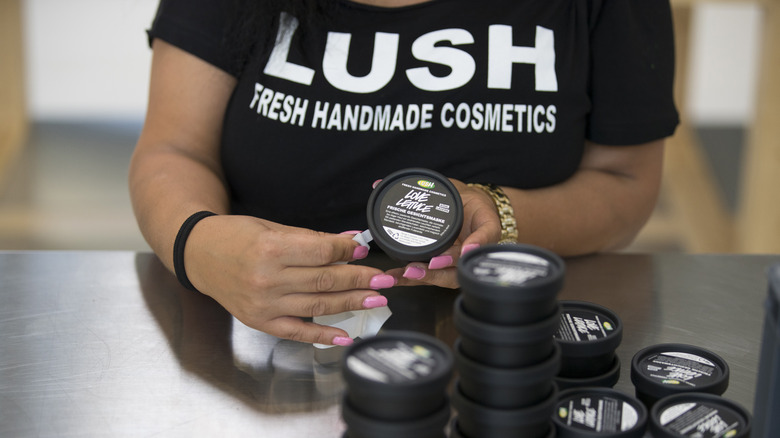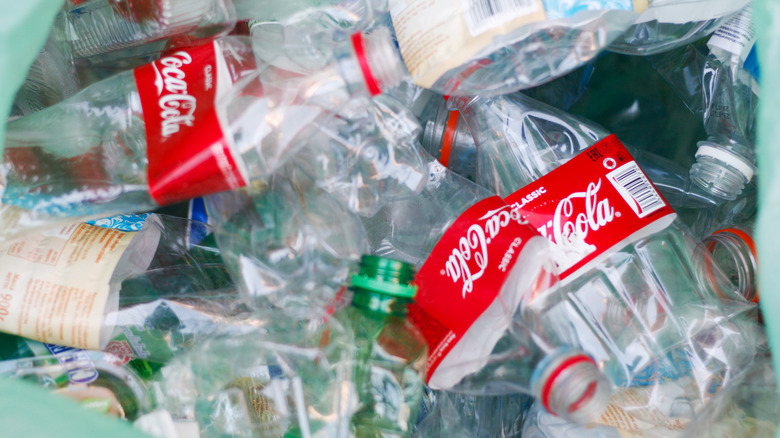Green Brands That Aren't As Sustainable As You Think
Turn on any television commercial or scroll past an ad on Facebook or Instagram, and you're bound to see brands touting their products as green, eco-friendly, and sustainable. There's a good reason for it, too. Green is in. The CGS 2019 U.S. Consumer Sustainability Survey found that consumers are willing to pay more for sustainable products — this is especially true among Gen Z consumers.
Despite this trend toward more eco-friendly purchasing, it isn't always easy to know when a brand is truly sustainable or whether its products are truly green. While the Federal Trade Commission has strict rules about terms like "biodegradable," "compostable," "recyclable," "non-toxic," and "ozone-friendly," there aren't as many guidelines about using terms like "green" or "eco-friendly." This means that sometimes, companies spend more money on marketing themselves as "green" than actually working to become sustainable or eco-friendly, a tactic that Business News Daily explains is called "greenwashing."
With that in mind, here are some "green" brands that aren't as sustainable as you think.
Amazon talks a good green game
Amazon is no doubt one of the most profitable companies in the United States. GoBankingRates conservatively estimated Amazon's net worth at the end of 2021 to be over $400 billion. They also tout themselves as being committed to the environment, co-founding The Climate Pledge in 2019 in the name of sustainability.
But Amazon is apparently only interested in sustainability if it doesn't hurt their bottom line. An anonymous source told the Seattle Times in 2020 that Amazon actually shot down a proposal for giving customers the opportunity to choose a "green" delivery option, because it might make them more hesitant to make their purchases. The company is also known for using way more packaging than needed for shipping, with the Twitter account Amazon Packaging Fails highlighting that it's a problem across the board.
Seemingly in response to claims they were greenwashing, Amazon launched an "eco-friendly" badge on their site in 2020, which purported to allow consumers to filter results to include only sustainable products. The problem, according to Ethical Consumer, is that their definition of eco-friendly included single-use items and inherently "environmentally damaging" products — so long as their packaging was considered efficient.
Thinx period underwear have some very un-green ingredients
Period underwear (that is, underwear that you can wear when you're on your period in lieu of a pad or tampon) sounds like a great idea for the environment. According to HuffPost, the average menstruating person who uses tampons will go through approximately 20 of them per cycle. That's a lot of waste compared to period underwear like Thinx, which are marketed to absorb up to five tampons' worth of flow and can then be washed and reused.
While cutting down on waste from single-use menstruation products is great and all, Thinx brand period underwear have come under fire for their apparent use of chemicals known as PFAS. According to the Agency for Toxic Substances and Disease Registry, PFAS never break down, so they always remain in the environment (and in the organisms, including humans) where they're deposited. For this reason, PFAS are known as "forever chemicals" and have been connected to negative health outcomes.
While PFAS are found throughout our environment, Thinx underwear reportedly contain more than consumers would reasonably expect to find in such products, suggesting they are intentionally used in their manufacturing — or so alleges the class action lawsuit against the brand.
BP, Exxon, and other green oil companies are misleading
While you may not immediately think "green" when you think of oil companies, many of them certainly want you to. Researchers who published their findings in PLOS One found that BP, Chevron, ExxonMobil, and Shell all tout commitments to transitioning to clean energy, but fall very short. According to the researchers, from 2009 to 2020 the companies increasingly made pledges related to becoming more environmentally friendly and spoke in terms of "low carbon" and "climate" strategies, but their actions did not align with those pledges. In fact, their business models all continue to rely on the use of fossil fuels, and the companies have made what the researchers call "insignificant" spending on clean energy.
Researchers aren't the only ones who have noticed, either. In 2019, ClientEarth lawyers filed a lawsuit against BP for their "Keep Advancing" and "Possibilities Everywhere" advertising campaigns for overstating their commitment to low carbon products, despite 96% of their yearly spending going toward oil and gas. The lawsuit was ultimately dropped when BP agreed to stop those particular ad campaigns, but it's likely only a matter of time before they and other oil companies find a new way to greenwash.
The parent company for Love Beauty and Planet is the opposite of green
When shopping for bath and beauty products, it's tempting to take products at face value. A nice package that highlights greenery or the planet and uses buzzwords that make you feel good about buying the product can be hard to resist. Take Love Beauty and Planet. The name alone makes you feel like you're doing something good for yourself and the world by using it. Indeed, the brand touts its sustainably sourced ingredients and packaging on their website.
The team at Better Goods, however, gives the brand low marks on everything, including ingredients, animal rights, and sustainability. Better Goods points out that Love Beauty and Planet's website is vague about its sustainability efforts and misleading about ingredients. The company also doesn't prioritize not testing on animals. Further, the Better Goods team points out that Love Beauty and Planet is owned by Unilever, which is the third highest plastic polluter in the world, according to Break Free From Plastic.
Nestlé has a sustainability problem across the board
Nestlé is the largest food and beverage company in the world, according to Forbes, and has far more brands than you may realize under its umbrella, including baby foods, frozen foods, pet care, nutrition, and more. With so many products, it's perhaps unsurprising that Nestlé was found to be the largest polluter in a brand audit during a beach cleanup in the Philippines in 2017.
In 2018, Nestlé announced a goal to have 100 percent of their packaging be either recyclable or reusable by 2025. While that certainly sounds admirable, Greenpeace immediately released a statement of their own, pointing out that the statement from Nestlé included no actual timeline or steps they planned to undertake to reach their goal. Two years later, Nestlé was identified as the third worst polluter in the world in Break Free From Plastic's 2020 brand audit.
Pollution isn't Nestlé's only sustainability problem. A 2019 class action complaint alleged that Nestlé not only had child labor in its supply chains, an issue for several chocolate manufacturers, but also that it had no environmental controls in place. The complaint further alleges that this makes the company's claims at being sustainable and fair trade false and misleading.
Starbucks missed the mark when trying to be green
According to Britannica, Starbucks is the largest coffee chain in the world. So you can imagine just how many cups and lids they go through in a single day. That's part of why, according to Fast Company, they promised in 2008 to make all of their cups either recyclable or reusable by 2015. Unfortunately, that didn't happen.
While the Starbucks paper cups may seem recyclable or compostable, they're lined with a type of plastic called polyethylene that makes this difficult, if not entirely impossible, according to CNN. While polyethylene is recyclable, the lining would need to be separated from the paper cup first, a step that just doesn't happen. This means that not only are Starbucks paper cups not recyclable, they contaminate recycling if they're included.
Starbucks has taken steps to reduce other types of waste, notably banning straws in their stores. What The Guardian points out, however, is that the strawless lid they use instead actually contains more plastic than the straws they banned. Even though they can be recycled, only nine percent of plastic is actually recycled (due in part to that aforementioned contamination).
Kauai Coffee's pods aren't 100% compostable like they advertise
There are many ways companies attempt to become more sustainable, including making it easier to dispose of their products once you finish with them in a more sustainable way. While we now know that coffee pods aren't as detrimental to the environment as we once feared, there's no denying that single-use products as a whole aren't the most environmentally friendly. So eco-conscious consumers are excited by innovations such as compostable coffee pods, like the "100% compostable" ones offered by Kauai Coffee.
The coffee pods have a catch though — they're only compostable in industrial facilities. The National Advertising Division of the Better Business Bureau reviewed Kauai's ads for the pods and wrote (via Truth in Advertising), "... this significant limitation appears in a barely legible font on the photo of the Kauai Coffee box, and in a similarly tiny font within the BPI certification seal itself..." The BPI is the Biodegradable Products Institute, which is the group that certified the Kauai pods as compostable in the first place.
Because industrial compostable facilities aren't available in all areas, many people will not be able to compost the pods at all, making them just another addition to landfills.
Kirkland cleaning products contain some scary ingredients
If you're a Costco shopper, you know the Kirkland Signature brand, which includes everything from clothing and groceries to cleaning products and pet supplies. It's the Kirkland Signature cleaning products in particular that aren't exactly what they seem. Several Kirkland cleaning products are marketed as being environmentally friendly, but that's one of those tricky terms that isn't exactly regulated. In fact, the products were previously marketed as environmentally responsible, but a class action lawsuit in 2018 claimed that the products were the exact opposite, and were actually toxic and harmful.
According to the lawsuit, the products used language and imagery that made consumers believe they were natural and safer than other products. Ultimately, the line of environmentally responsible products was renamed to become the current environmentally friendly line, which is a term a little less contentious. The products themselves don't seem to fare any better in an analysis by the Environmental Working Group, making them apparently no better for the earth than any other cleaning products you could spend your money on.
Method cleaning products aren't as green as advertised
Kirkland isn't the only brand of cleaning products to be called out for failing to meet their own claims. Method cleaning products, of which many are labeled and marketed as non-toxic, were the subject of a class action complaint filed against them and their parent company, SC Johnson & Son, Inc., in 2020. The complaint was based on the fact that the Federal Trade Commission has guidelines about what is required when claiming a product is non-toxic — and the Method products in question allegedly don't meet those requirements.
According to the complaint, "the Products contain various cleaning agents that would each, separately, disqualify the Products from making an unqualified non-toxic claim: dipropylene glycol, phenoxyethanol, linalool, methylisothiazolinone, limonene and octylisothiazolinone." These ingredients can reportedly cause a range of issues that include eye damage, nervous system dysfunction, allergic reactions, and harm to aquatic animals, to name a few.
The Environmental Working Group has similarly rated Method products low in terms of healthy cleaning. Of the 65 products reviewed, 43 received either a D or an F based on their ingredients. Not exactly the non-toxic products you were hoping for.
Simple Green isn't simply green
Non-toxic, biodegradable, and safer are all words that Simple Green All-Purpose cleaner uses on its packaging, but if we've learned anything, it's that labels can be misleading — or downright inaccurate. Simple Green joined other supposed green cleaning products that are at the center of their own class action lawsuit when a complaint was filed against the brand in 2020.
According to the complaint, "[Simple Green] products are, in fact, toxic, because they contain ingredients that have been linked to blurred vision, asphyxiation, dizziness, nausea, blistering of the skin, muscular twitching, headaches, and irregular heartbeat. Additionally, some of the toxic ingredients are potential human carcinogens."
It's not the first time Simple Green has come under fire for its ingredients. In 2007, a women's research group revealed that Simple Green was among a group of products that contained an ingredient connected to fertility problems, according to SF Gate. While some Simple Green products fare better than others in a breakdown by the Environmental Working Group, the majority of Simple Green products scored an F. Better to skip this one if non-toxic is a priority for you.
H&M's attempt at sustainability is greenwashing
H&M sells what is known as fast fashion, inexpensive and trendy clothing that, according to Good on You, is typically discarded after just a few wears. The short lifespan of fast fashion is part of what makes it so bad for the environment, as the clothing ends up in landfills and environmental resources are depleted by the production of more and more clothing. As Varsity points out, H&M and other fast fashion giants don't readily share the details of their supply chains or their policies around the environment and the impact their production process has.
In a bid to be more sustainable, H&M released their Conscious line of clothing. According to their website, at least 50 percent of each piece in the collection is made from materials that are more sustainable, except in the case of recycled cotton (which they say can only be 20 percent of a product due to quality concerns). What "more sustainable" ultimately means is pretty vague, a hallmark of greenwashing, as pointed out by consumers, Synthetics Anonymous, and the Norwegian Consumer Authority, to name just a few.
Lush Cosmetics has some sustainability shortcomings
The beauty industry is known to have quite the environmental impact problem, which is why a company like Lush Cosmetics that has a commitment to reducing their environmental impact comes as a breath of fresh air. While the company lays out some seemingly lofty goals in their environmental ethos, including being zero waste, many of their commitments are vague, such as, "Protecting water quality across our value chain" and "Inspiring customers to become water stewards." As Ethical Consumer points out, none of the commitments they make have any quantifiable measurement, so there's no way to keep them accountable.
Lush has also come under fire for their use of palm oil and, while they have a commitment to remove palm from all of their products, that hasn't yet happened. Just like their environmental ethos, their stance on palm is somewhat vague. Their website states, "Our work continues to remove all traces of palm oil from our products down to the very last drop," but doesn't provide a timeline or information about accountability.
Coca-Cola is the number one plastic polluter in the world
Coca-Cola is the strongest soft drink brand in the world with a brand value of $33.2 billion, according to Brand Finance. That's a lot of soda, Powerade, Minute Maid, and smartwater bottles, to name just a few of the products the Coca-Cola Company distributes. It seems fitting, then, that their commitment to sustainability is a lofty one that has been ongoing for years. That is, until you dig into their claims and the lawsuit that alleges it's nothing more than greenwashing. Despite their claims of sustainability and environmental-friendliness, all those plastic bottles have to go somewhere.
In their 2020 global Brand Audit Report, Break Free From Plastic found that Coca-Cola continues to be the number one plastic polluter in the world. This fact is corroborated by the Talking Trash report by the Changing Markets Foundation, which revealed that Coca-Cola has a plastic footprint of 2.9 million tonnes per year, despite claiming some lofty environmental goals for decades — goals, we should add, that they've continually failed to meet.
How can you tell when a brand is really green?
It's clear that brands will do just about anything to market themselves as sustainable and eco-friendly these days, so how is a consumer supposed to navigate all the deceptive practices and find brands that are truly green?
Andreas Rasche, a professor of business in society at the Copenhagen Business School's Centre for Sustainability, told CBS News that another good tactic is to do some digging on the company to see who invests in the brand (and what the brand itself invests in). Rasche also warns to be skeptical of buzzwords. "You can use these words and there are very few legal definitions around it, depends a little bit on the country," he said, explaining that vague words and promises should raise red flags.
According to Waste Advantage magazine, while things like "natural" and "eco-friendly" aren't regulated, there are certifications you can look for to see if a brand is actually environmentally friendly, such as Energy Star, the USDA Organic Seal, the Forest Stewardship Council, and the Green Seal.
